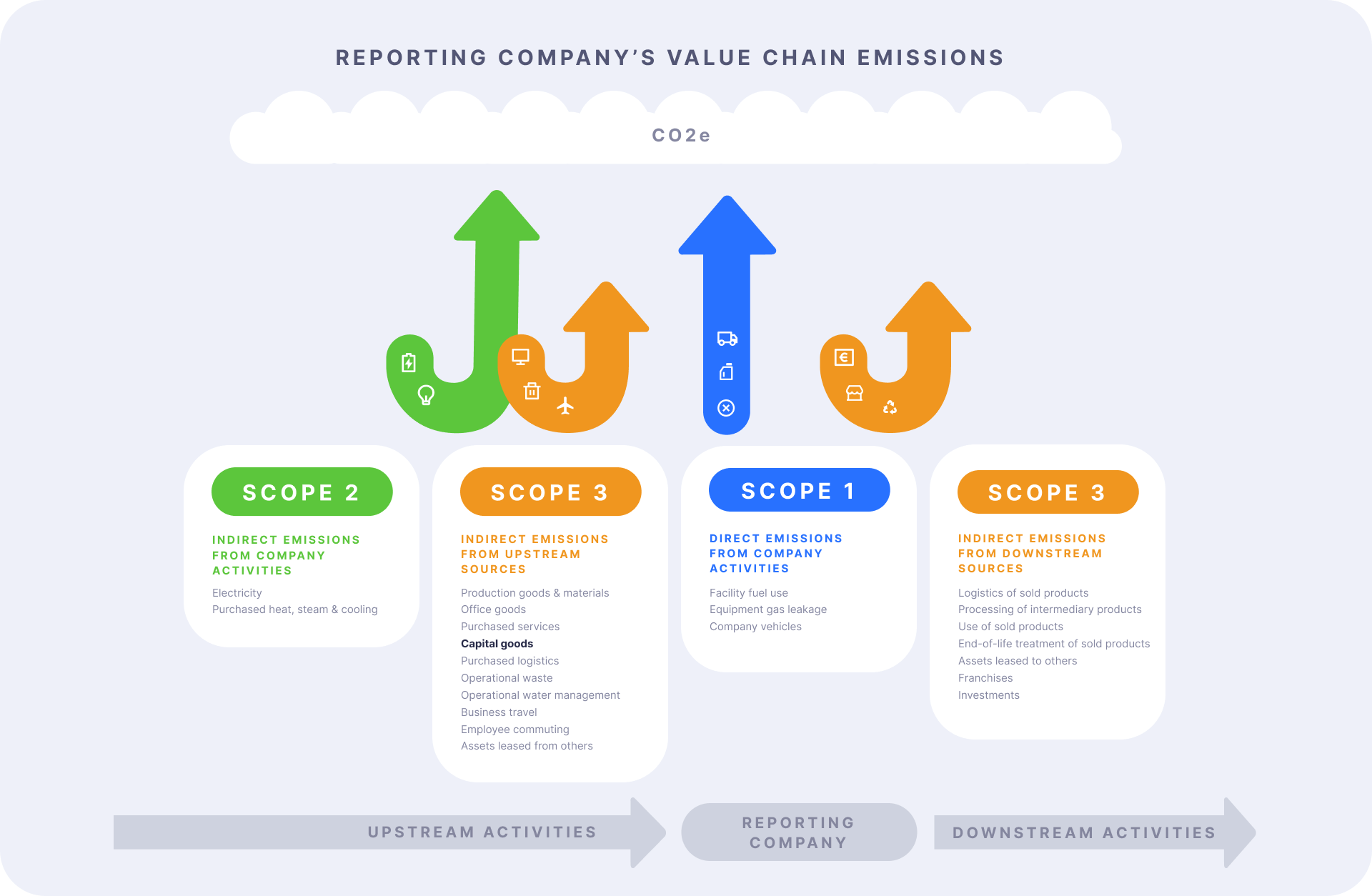Scope 3.2: Capital goods
Final products that are used by the company to manufacture a product, provide a service or sell, store and deliver merchandise
Capital goods are final products that have an extended life and are used by the company to manufacture a product, provide a service or sell, store and deliver merchandise (e.g. equipment, machinery, buildings, facilities and vehicles).
This category includes:
-
All upstream (cradle-to-gate) emissions from the production of Capital goods purchased or acquired by the reporting company in the reporting Log.
the category excludes:
-
Emissions from the use of Capital goods by the reporting company (e.g. for fuel use and electricity use)
-
Transport upstream of tier 1 (direct) supplier to company

How this Category aligns to carbon accounting standards
The GHG Protocol Corporate Standard is an internationally recognized go-to standard for estimating and reporting corporate GHG emissions. GHG emissions are categorised into three 'Scopes'.
Scope 3 emissions are all indirect emissions – not included in scope 2 – that occur in the value chain of the reporting company. In other words, the emissions that are linked to the company’s operations. Activities covered by scope 3 emissions are diverse, but sit in two high level categories:
-
Upstream emissions are indirect emissions related to purchased or acquired goods and services (all the emissions occurring to the point of receipt by the company: material sourcing and pre-processing)
-
Downstream emissions are indirect emissions related to sold goods and services (all the emissions occurring after being sold by the reporting company: distribution, storage, use, end-of-life)
The Cozero category, Capital goods, is an upstream source of scope 3 emissions, as defined by the GHG Protocol. All emission calculation methodologies follow the requirements for this scope of emission accounting.
Summary of calculation methods
Here are the different calculation methods available on the Log to calculate scope 3 emissions from Capital Goods. These methods are listed in order of how specific the calculation is. Users should choose the method that is the most appropriate to the data available to them, to their business goals and the significance of the emissions of the category.
Consumption
Emissions are estimated by collecting data on the number of goods bought during the reporting period and multiplying by the relevant emission factor.
• Activity data: quantity of goods bought within the reporting period in kg or m2, depending on the capital goods selected. The Log provides conversion of other units.
• Emission factor: Cozero provides a default cradle-to-gate emission factor of the capital goods per unit of product (kgCO2e/kg or kgCO2e/m2) but users can also enter supplier-specific emission factors.
How to report emissions in Cozero?
• Step 1: Select the category called Capital goods
• Step 2: Select the subcategory you want to report on (e.g. Building and facilities)
• Step 3: Choose the type of good you want to report on within the additional levels of details
• Step 4: Enter the quantity in kg if you are reporting on Machine and equipment or Automotives and other vehicles or enter the surface in m2 if you are reporting on Building and facilities.
• Step 5: (If available, amend the emission factor with your own supplier-specific emission factor)
Cozero will automatically calculate the emissions for the quantity or surface of units entered
Direct emission Input
Users can enter the amount of emissions in CO2e directly in the log. They need to make sure of the accuracy of data used in this estimation.
Where can I find data?
- Activity Data:
-> Internal data systems (e.g. bill of materials)
-> Purchasing records
Note that data quality is an iterative process and should be built over time. Therefore there is no need to have the perfect data right away. For more information on data collection see the article on data sourcing.
FAQ
For additional information on the calculation of scope 3 emissions, users can refer to the GHG Protocol Guidance. Please get in touch with our team if there is a frequent need to make use of this Log emission category and you require additional support in the calculation of emissions.